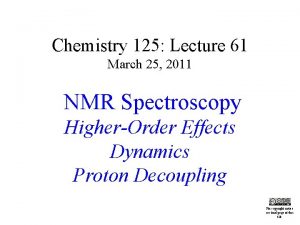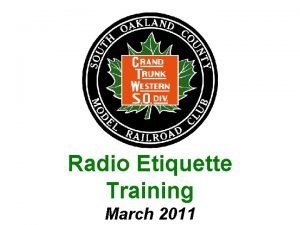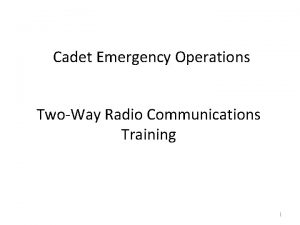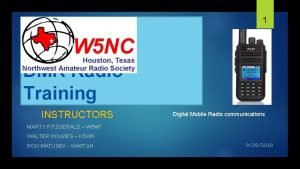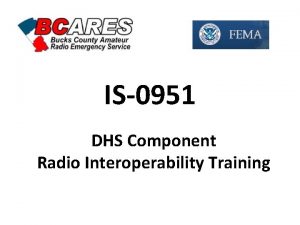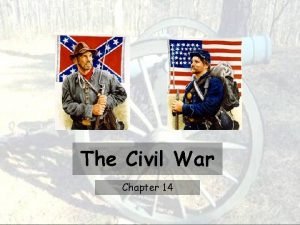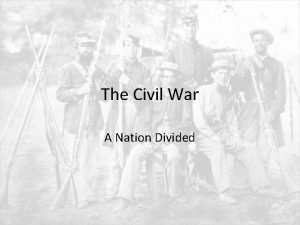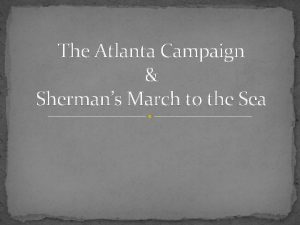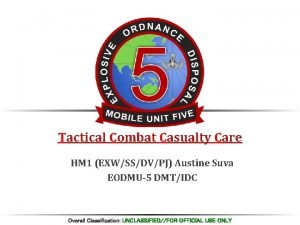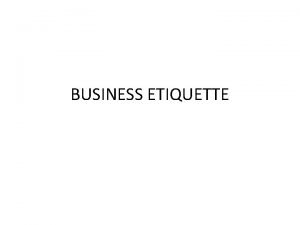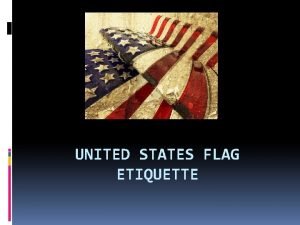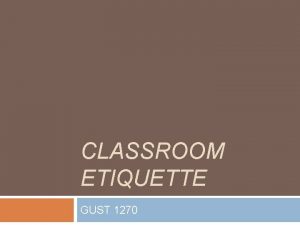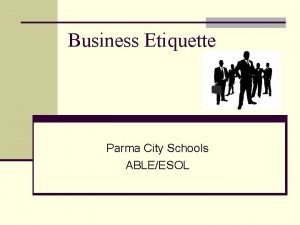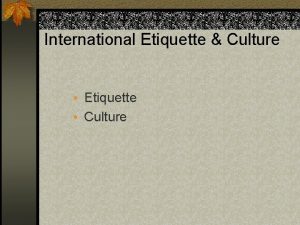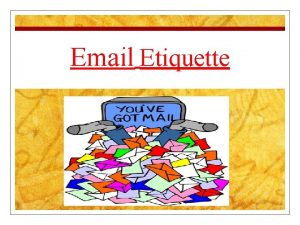Radio Etiquette Training March 2011 RADIO ETIQUETTE During

















- Slides: 17

Radio Etiquette Training March 2011

RADIO ETIQUETTE • During formal card order sessions, conversations on the radio also need to be formal. – We are attempting to copy prototype practices, which applies to communications as well as how we run the trains. – The objective is to be clear, consistent, concise and completely understood. – Note: conversations on the Yard telephones do not need to be formal, but communications still need to be clear and understood by both parties.

RADIO ETIQUETTE • Per prototype radio rules (as defined by the FRA’s General Code of Operating Rules), here are the proper practices for use of the radio: a. Before transmitting, listen first. b. Give the required identification. c. Do not proceed with further transmission until a response is received. d. Properly end the transmission.

RADIO ETIQUETTE A. LISTEN FIRST! – Before transmitting, listen long enough to make sure that the radio is not in use. • • • Listen long enough to make sure that another radio conversation is not in progress. DO NOT INTERRUPT an on-going conversation. Be aware that some conversations may have a few seconds between transmittals, so listen 5 – 10 seconds unless you know the last conversation has been completed.

RADIO ETIQUETTE B. REQUIRED IDENTIFICATION – An employee transmitting a radio communication must begin with positive identification which must include the following in the order listed: • • • Name or initials of the railroad. Occupation, or Train name (number), engine number, location, or words that identify the precise unit.

RADIO ETIQUETTE B. EXAMPLES “TD 2, this is Train Number 700. ” “Train 700, this is TD 2 answering, over. ” or: “Go Ahead, Train 700. ” or: “TD 2 answering. ” or: “Stand-by, Train 700. ” “TD 2 calling Train 351 in Clarkston. ” “This is Train 351, over. ”

RADIO ETIQUETTE C. MESSAGE – After identification, the communication may continue. The conversation should be brief, but convey the essential information that the other party needs. • Note that the Dispatcher’s response may be delayed if he is multi-tasking, talking on the telephone, or lining up a route for you…

RADIO ETIQUETTE C. EXAMPLE MESSAGES “TD 2, Train 700 requests Track & Time authority between. . . , over. ” “TD 2, Train 351 has completed my work at … , over. ” “TD 2, Train 250 is stopped at Yellow Cab looking at all red signals, over. ” “Train 79, you have Track & Time authority at the Holly Interchange, over. ” “Train 411, hold the siding at Linden for two westbound extras, report when you are in the clear, over. ”

RADIO ETIQUETTE D. REPETITION – Any communication from the Dispatcher that gives an order, provides instructions, clearance to take an action, or is complex, must be repeated by the Train Crew to ensure that the communication was clearly understood. “An employee who receives a transmission must repeat it to the transmitting party except when the communication is general in nature and does not contain any information, instruction or advice which could affect the safety of a railroad operation. ”

RADIO ETIQUETTE D. REPETITION EXAMPLE “Train 200, you have Track and Time authority in Birmingham, over. ” “TD 2, Train 200 understands that I have Track and Time in Birmingham, over. ” “That is correct, Train 200. TD 2, out. ”

RADIO ETIQUETTE D. REPETITION EXAMPLE “Train 100, you have permission on the Holly Subdivision out of Johnson Avenue, following signal indication to Ferndale Yard, over. ” “Train 100 copies, permission on the Holly Sub out of Johnson Avenue via signal indication, over. ” “ TD 2, out. ”

RADIO ETIQUETTE D. REPETITION SHORT-CUTS – Where the instruction is not complex, or the communication is general, the repetition or acknowledgement can be shortened. “Copy that, TD 2. Train 900, out. ” “Train 61 copies, over. ” – Crews must use their judgment when to use these shortcuts. Remember that the Dispatcher can require a full repeat-back if he feels it is necessary.

RADIO ETIQUETTE D. ACKNOWLEDGEMENTS – To indicate to the Dispatcher that you understand instructions you have been given, you must answer with an acknowledgement. – The only proper acknowledgements in railroad radio are: • • A Repeat-Back “Train XXX Copies” – NEVER use “ 10 -4”, “Roger”, “OK”, or any other response.

RADIO ETIQUETTE E. END TRANSMISSIONS – To clearly identify when a communication is complete, one or both parties should close a transmission with the word “OUT”. Example: “Train 510 copies; out. ” “TD 2, out. ” – If the Dispatcher closes a transmission with “Out”, no response is required from the Train Crew. Example: “That is correct, Train 80. TD 2, out”

RADIO ETIQUETTE E. The difference between “OUT” and “OVER” – Use “Over” at the end of your transmission when a response is expected. – Use “Out” at the end of your transmission when the communication is complete and no response is expected.

RADIO ETIQUETTE The Dispatcher’s biggest peeve: – Crews not paying attention to the radio! – Everyone should be alert to a transmission that begins with: “TD 2 calling Train. . . , over” – Dispatcher will move on to other traffic if you don’t respond to his call. . .

This has been a presentation of:
 Anthem of poland
Anthem of poland March 25 2011
March 25 2011 Radio etiquette training
Radio etiquette training Unprofestional
Unprofestional Awin support
Awin support Two way radio communication training
Two way radio communication training Brandmeister login
Brandmeister login Radio interoperability web based training
Radio interoperability web based training Grihalakshmi magazine march 2019
Grihalakshmi magazine march 2019 Where was vincent van gogh born
Where was vincent van gogh born Source russia march
Source russia march March 1917 revolution
March 1917 revolution Sherman's march to the sea map
Sherman's march to the sea map Sherman's march significance
Sherman's march significance Path of sherman's march to the sea
Path of sherman's march to the sea Path of sherman's march to the sea
Path of sherman's march to the sea Mist tccc
Mist tccc Aleida march de la torre
Aleida march de la torre

